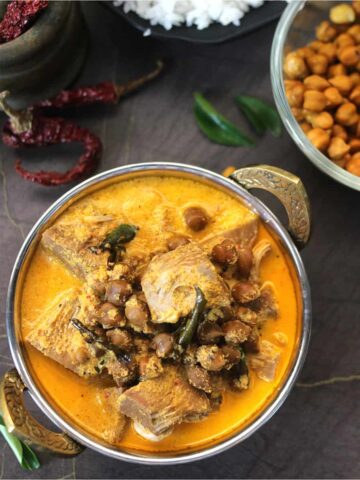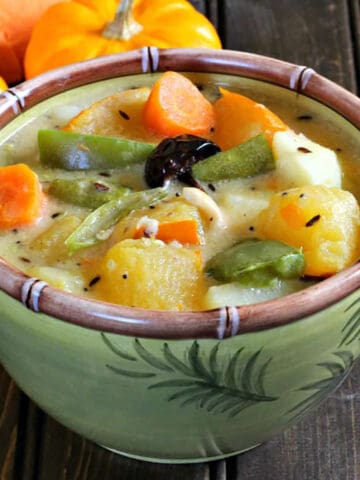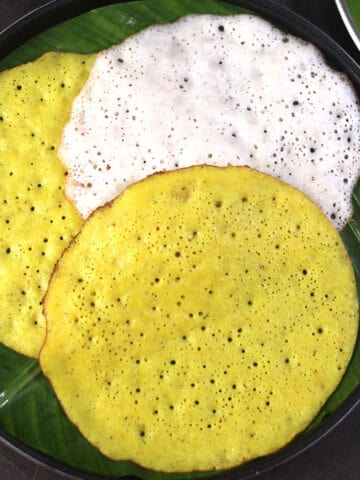Also, check out Ganesh chaturthi recipes, Janmashtami recipes, and Navratri recipes.
What is the meaning of gajbaje?
Gajbaje means concoction (mixture of various ingredients). It is a flavorful curry made from seasonal vegetables, specially made during Krishna Janmashtami and Ganesh Chaturthi.
Konkani Gajbaje
This gajbaje is also known as ashtami gajbaje or chavthi gajbaje because of the number of ingredients that goes in. I have made gajbaje several times in the United States but with vegetables available in the fresh market. So let me tell you what vegetables fit in for a traditional gajbaje, so it tastes like my favorite Karkala temple samaradhane one.
Beans Cow pea beans/long beans (alsando) Pumpkin (dudde) Sweet potato (kananga) Indian yam (surnu) Potato (batato) Sweet corn (jolu) Ivy gourd (tendle) Ridge gourd (gosale) Yellow cucumber (magge) Raw banana (randai kele) Cantola/teasel gourd (phagila) Bread fruit (jeev kadgi) Bajje dentu Hog plum (ambado) Surna venti Carrot
I would suggest you add more variety of vegetables so that the flavor of all vegetables combines and enhances the taste. Serve it along with khotto, idli or steamed rice.
Ingredients
For the coconut paste, freshly grated coconut, dry red chilies, and cashews are used. For tempering, use coconut oil, mustard seeds, and curry leaves. For the curry: Mixed vegetables from the list available in season. Check out the recipe card for the full list of the ingredients.
Step-by-step instructions
Chop and wash the vegetables. Keep this aside. Use those vegetables that are easily available. In a pot, add water along with vegetables that require more time to cook, such as potatoes, sweet potatoes, pumpkin, sweet corn, and Mangalore cucumber. When these vegetables are halfway cooked, add the remaining vegetables, curry leaves, and green chilies and cook all the vegetables together. Meanwhile, add coconut, red chilies, and cashews with a little water to a mixer jar or blender and blend to form a smooth paste. Now add the ground paste and salt to the vegetables and adjust the water to the desired consistency. This should be a medium-thick curry. Bring it to a nice boil and simmer for 5 to 10 minutes. Meanwhile heat oil in pan. Add mustard seeds, when they splutter add curry leaves and switch off the flame. Add this tempering to the curry. Serve this hot with rice, or Mangalorean kotto, and soft and fluffy idli, and enjoy.
Tips
You can keep the leftovers in the refrigerator for 2 to 3 days. They taste great, as the flavors of the vegetables combine well. Every time I make this dish, I add the available vegetables. You don’t have to add all the vegetables, but the more variety, the better. Adding cashews is my mom’s way, so it also makes the dish thick, rich, and creamy. You can increase the curry leaves you add to the dish while boiling vegetables. Adjust the chilies based on how spicy you like the dish to be.
More konkani recipes
Did you like this recipe? Please leave a star ⭐️⭐️⭐️⭐️⭐️ rating below and/or a review in the comments section. You can also stay in touch with us through social media by following us on Pinterest, Facebook, Instagram, and Twitter.
Recipe card








